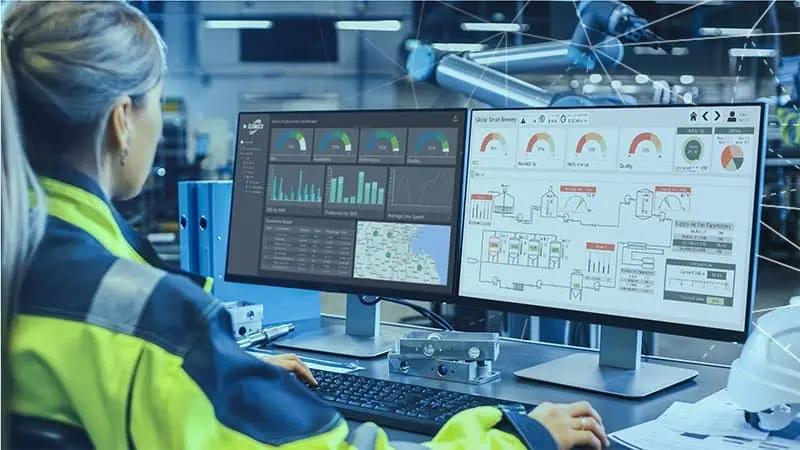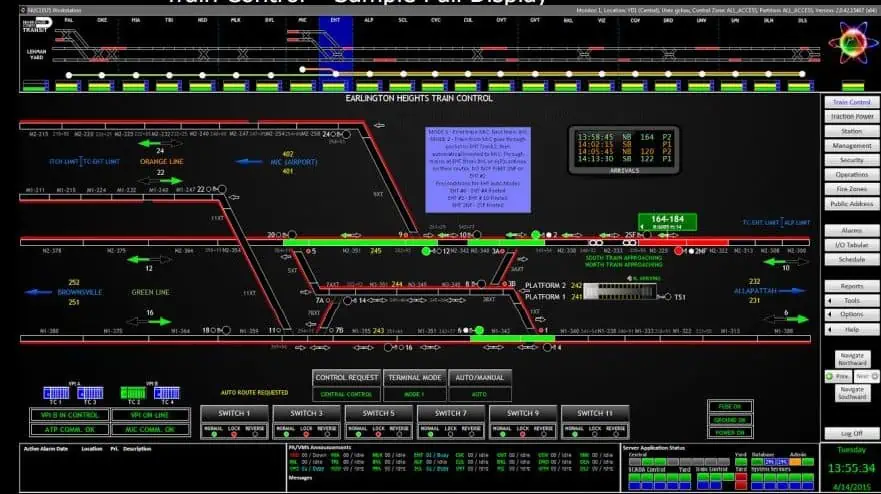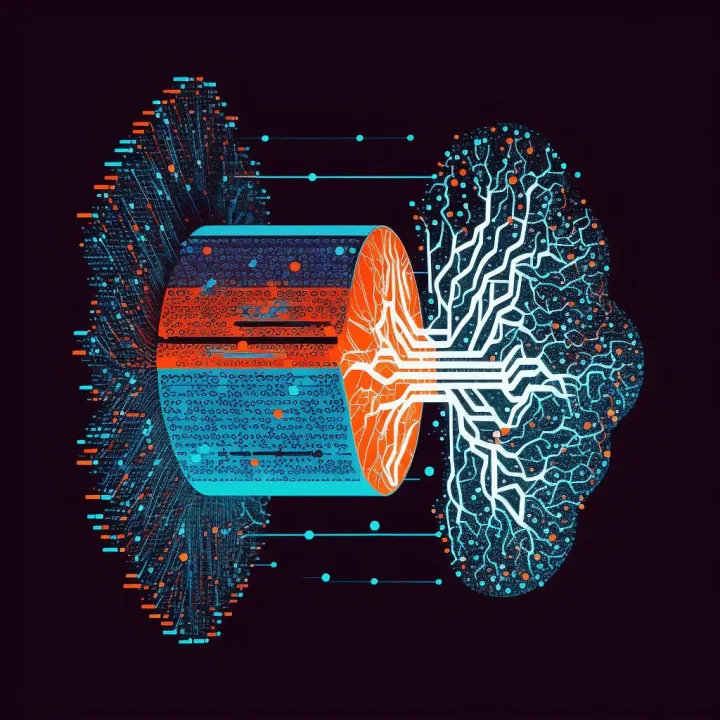What is SCADA and how is it used in Rail Operations
SCADA (Supervisory Control and Data Acquisition) technology is transforming the rail industry by enabling more efficient and reliable operations. SCADA in rail operations, its benefits, and the technology behind it. Discover how our SCADA solutions can help your business

SCADA, or Supervisory Control and Data Acquisition, is a control system that monitors and regulates industrial processes and machinery that is transforming the rail industry. Sensors, Programmable Logic Controllers (PLC), and Human Machine Interfaces (HMI) collect data from various industrial processes. This data is displayed on a Graphical User Interface (GUI), which lets operators keep track of the status of their systems and modify the process as needed. SCADA systems are mainly found in the Transportation sector, Energy Production, and Manufacturing.
What is SCADA?
SCADA is a control system used in industrial settings to monitor and control various processes. SCADA systems are composed of multiple components, including sensors and actuators, remote terminal units (RTUs), programmable logic controllers (PLCs), a human-machine interface (HMI), and a supervisory computer (SCADA) software. These components work together to collect sensor data and send commands to actuators to control the industrial process being monitored. SCADA systems are typically used in transportation, manufacturing, power generation, and oil and gas production to monitor and control processes such as temperature, pressure, flow rate, and chemical composition.

Technology Used in SCADA
SCADA systems use various technologies to collect and process data from industrial processes and equipment. Some of the key technologies used in SCADA systems include:
- Sensors: SCADA systems rely on sensors to measure parameters such as temperature, pressure, flow rate, and more. Sensors are typically connected to a programmable logic controller (PLC), which converts the sensor data into digital signals that the SCADA system can process.
- Programmable Logic Controllers (PLCs): PLCs are microprocessor-based controllers that are used to control industrial processes and equipment. They are often used to control motors, valves, and other devices that are used in industrial automation. PLCs can be programmed to respond to specific inputs and perform particular tasks.
- Human-Machine Interfaces (HMIs): HMIs are graphical user interfaces that are used to display data and allow operators to interact with the SCADA system. HMIs typically include displays, touchscreens, and input devices such as keyboards and mice.
- Communication Networks: SCADA systems rely on communication networks to transmit data between sensors, PLCs, and HMIs. Communication networks can be wired or wireless and may use protocols like Modbus, DNP3, and OPC to communicate data.
- Data Storage and Analysis: SCADA systems typically include data storage and analysis capabilities that allow operators to review historical data and identify trends and patterns in the performance of the industrial process or equipment. This data can be used to improve process efficiency, identify areas for improvement, and make more informed decisions about the system's operation.
How do SCADA systems work?
SCADA systems collect data from sensors installed in the industrial process being monitored and transmit that data to a remote terminal unit (RTU) or programmable logic controller (PLC), which then processes the data and sends commands to actuators to adjust the process as needed. Some standard communication protocols used in SCADA systems include Modbus, DNP3, and OPC-UA. These communication protocols allow for secure and reliable data exchange between the various components of a SCADA system. Here's a general overview of how SCADA systems work:
- Data collection: SCADA systems collect data from sensors and devices connected to the industrial process or system. These sensors and devices may measure temperature, pressure, flow rate, etc.
- Data processing: Once data is collected, it is processed by the SCADA system to make it worthwhile. Data is typically converted into digital signals that can be analyzed by the system.
- Control: The SCADA system uses the data it collects to control the industrial process or system. For example, it may turn on or off a motor, open or close a valve, or adjust a temperature setting.
- Human-Machine Interface (HMI): The HMI is part of the SCADA system that allows operators to interact with the system. Operators can use the HMI to view data and adjust the system as needed.
- Data storage and analysis: SCADA systems typically store data for analysis and reporting. This data can be used to identify trends, predict system performance, and optimize the system's operation over time.
How SCADA Systems are used in Rail Operations
SCADA systems used in rail operations monitor and control various processes such as train speed, track switch positions, signal status, and traction power. These systems are also used for monitoring the condition of railway infrastructure and detecting faults such as broken rails or malfunctioning switches.
SCADA systems in rail operations have been shown to increase efficiency and safety by allowing for real-time monitoring and control of critical railway processes. Benefits of SCADA Systems in Rail Operations Improved reliability, increased safety, reduced downtime, and enhanced operational efficiency are among the benefits of using SCADA systems in rail operations. These benefits are achieved through the ability of SCADA systems to detect faults and anomalies in real-time, allowing for prompt corrective actions.
Real-time monitoring of railway processes also allows for faster response times to train speed and other operational issues. This can reduce the time required to stop a train or take corrective action when needed, increasing safety and enhancing efficiency. SCADA systems are also used for predictive maintenance, which helps identify potential problems before they become significant.

Finally, SCADA systems provide data analysis and reporting capabilities, allowing operators to evaluate system performance and make informed decisions.SCADA systems also provide improved asset management and decision-making by providing real-time data on the condition of railway infrastructure. This data can alert operators to potential failures or problems, allowing them to take preventive action before costly repairs are needed.
By monitoring the condition of the railway infrastructure, SCADA systems can also be used to optimize maintenance schedules and reduce the need for frequent inspections. In addition, SCADA systems can be used to improve energy efficiency by detecting high-energy consumption and taking corrective action.
Programming of SCADA System
Programming a SCADA system requires a thorough understanding of the hardware and software components that make up the system. In most cases, SCADA systems are programmed using a proprietary language, such as ladder logic or Structured Text. The programming language creates commands and instructions, allowing the SCADA system to interact with devices in various ways, such as reading sensor data, sending control signals to output devices, and controlling alarms.
Programming a SCADA system typically involves a few key steps:
- Define system requirements: The first step in programming a SCADA system is to define the system requirements. This includes identifying the sensors, devices, and other equipment that will be used in the system, as well as the data that needs to be collected and the tasks that the system needs to perform.
- Develop a PLC program: Once the system requirements are defined, a program must be developed for the programmable logic controllers (PLCs) that will be used in the system. The PLC program defines how the system will collect and process data, and how it will respond to different conditions.
- Develop an HMI: The human-machine interface (HMI) is the part of the SCADA system that allows operators to interact with the system. The HMI must be developed to display data from the system and allow operators to make adjustments to the system as needed.
- Integrate the system: Once the PLC program and HMI are developed, they must be integrated into the larger SCADA system. This may involve connecting sensors and other devices to the system, configuring communication networks, and testing the system to ensure that it works as intended.
- Test and optimize the system: Finally, the SCADA system must be tested and optimized to ensure that it meets the requirements defined in step 1. This may involve adjusting the PLC program, fine-tuning the HMI, and making other adjustments to the system as needed.
In addition to the programming, ensuring the SCADA system is properly configured is also important. This involves testing and configuring the system's hardware components, such as network interfaces, communication links, and control systems. Once the hardware is set up, it must be integrated into a larger network and connected to other systems in order to provide comprehensive monitoring and control capabilities.
For the SCADA system to run correctly, it is essential that security measures are taken. Security measures include user access controls, data encryption, and anti-virus protection. These measures ensure that the SCADA system is kept secure from malicious actors attempting to access the system without permission or disrupting its operations. Additionally, periodic maintenance must be performed on the SCADA system in order to ensure that it is running properly and efficiently.
Overall, programming a SCADA system requires a technical understanding of the hardware and software components involved in the system and knowledge of security measures to protect it from malicious actors. Additionally, regular maintenance is essential in order to keep the system functioning properly. With the right knowledge and resources, any individual or organization can program and maintain a robust SCADA system.
Security Concerns in SCADA Systems
SCADA systems are critical infrastructures that require high levels of security to prevent cyber-attacks and unauthorized access. The security concerns in SCADA systems are a major issue due to their critical infrastructure and the potential consequences of a cyber attack or unauthorized access.
Some of the security concerns in SCADA systems include vulnerability to malware and cyber attacks, as well as issues with outdated software and hardware that may have known security vulnerabilities. To mitigate these security concerns, various measures can be taken, such as implementing firewalls and intrusion detection systems, regularly updating software and hardware components to the latest versions with security patches, limiting access to the SCADA system only to authorized personnel, and conducting regular security audits and risk assessments to ensure that any potential security risks are identified and addressed promptly.
Overall, it is essential for organizations using SCADA systems to prioritize and invest in comprehensive security measures to safeguard critical infrastructure and prevent potential cyber-attacks or unauthorized access.
In conclusion, SCADA systems play a crucial role in monitoring and controlling various industrial processes and are essential for ensuring the efficient and safe operation of critical infrastructure in industries such as transportation.
However, as with any technology that relies on data exchange and remote access, SCADA systems are not immune to security concerns and require extensive security measures to prevent potential cyber-attacks and unauthorized access. Some of the security measures that can be taken to mitigate security concerns in SCADA systems include implementing firewalls and intrusion detection systems and regularly updating software and hardware components to the latest versions with security patches. Limiting access to the SCADA system only to authorized personnel and conducting regular security audits and risk assessments.
We can help you
Harness the potential of SCADA Solutions – let us guide you on an innovative journey, bringing next-gen technology to your customers!





